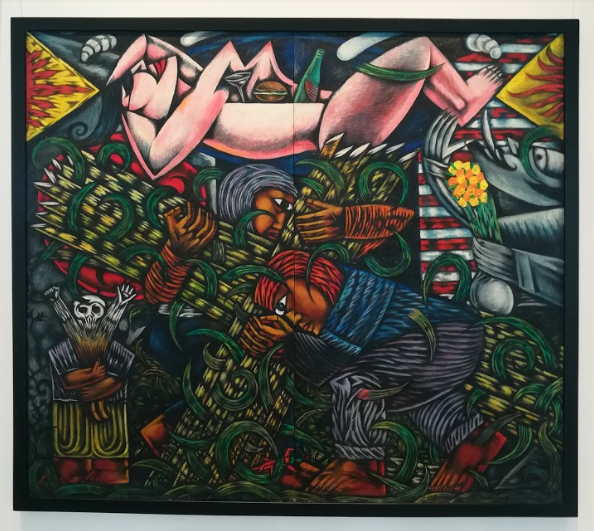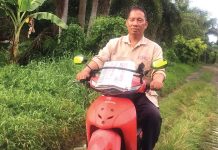
IN FAMED Negrense artist Nunelucio Alvarado’s “Katawhay Sa Pangabuhi” (“A Peaceful Way of Living”) – an opus of his from 1994 – he paints two sacada workers struggling to haul their “cross to bear”: mammoth bundles of sugarcane heavy on their shoulders, all while a depraved figure lays nonchalant above them, unbothered by the toil and labor beneath her.
“In Negros Occidental, the word ‘refine’ has sat side by side with the word ‘sugar’ for almost 100 years [the process of removing any and all impurities from raw sugar] so much so that the province’s main commodity of refined sugar has come to be synonymous with Negros,” reads curator Gina Olivares Jocson’s notes for the 23-man show “Unrefining Sugarlandia,” which includes the Alvarado masterwork, at the Negros Museum.

In the same way, “Negros in recent years has benefited from a proliferation of glossy publicity about its manifold pleasurable attractions,” she continued. “From paid advertisements by private businesses and the local government, to social media uploads by eager bloggers and Instagrammers, there has emerged a sweet vision of what makes up the province: laidback living and calorific delicacies, romantic colonial-era mansions and idyllic sugarcane fields, headdress-heavy dancers with perpetual grins.”

“Looking beyond the shiny polish that has coated their province, these 23 artists have produced artworks that expose what touristic write-ups fail to see,” explained Jocson, who has previously worked with the National Art Gallery of Singapore.

RAW SUGAR
“The sugarcane field was the playground of children in the past. I remember, we would gather there and play. The sugarcane field is part of my identity,” recalls terracotta artist Susanito Sarnate. “When it was harvest time, my friends and I would go [to the fields] straight from school. It was our merienda area because we would eat and suckle the tubo that had already been cut and on the ground. We were innocent children. We did not realize that in the same field we were surrounded by dangerous people.”

In “Memories in Red and Pink,” Sarnate pulls from his recollections to assemble a tableau of his signature figurines, merrymaking and crouching among piles of harvested sugarcane, unknowingly surrounded by bolo-wielding bandits and gun-toting mercenaries clad in fatigue and army boots, one of them brandishing a patch marked “CAFGU,” meaning Citizen Armed Force Geographical Unit, a paramilitary group under the Armed Forces of the Philippines.
“Unrefining Sugarlandia” comes at an opportune time, with the recent massacre of nine sacada workers – among them two minors and four women – in Hacienda Nene, Barangay Bulanon, Sagay City, Negros Occidental, providing a much-needed venue to discuss the injustices and atrocities the peasants of Negros have had to endure for decades.

Veteran Negrense artist Charlie Co bares his distinct broad strokes in “Roli,” a tribute to a gallery worker of his, a former sacada sugarcane cutter who started working in the fields at 12 years old. He depicts “Roli” with a pained expression as he stares directly at the audience, his anguish following you around the room. Just behind the young sacada lurks a shadowy death-masked figure and a sugar baron on his high horse.
Co’s influence on other Negrense artists is evident in the works of Jay-R Delleva and Raymond Legaspi. Delleva’s optimistic “Ang Batang Negros” proves reminiscent of Co’s iconic “Angry Christ” mural at the St. Joseph the Worker Parish Church in Victorias City, while Legaspi’s “It’s Not the Real Thing” – a rift on the indelible 1970s Coca-Cola commercial and commentary on the soft drink producer’s shift to high-fructose corn syrup late last year – rendered in hot red, evokes the macabre of Co’s oft-times grimacing characters.

Karina Broce-Gonzaga and Moreen Austria take a more familial approach. Depending on how you interpret it, Gonzaga either paints four generations of women stuck in the vicious cycle of the sacada or the same woman at different points in her life in “Blind Faith,” portraying them naked and veiled, the heavy texture of molasses running down their bodies.
“In one year in the sugar farm, there are two cycles: planting, harvest, then planting again and harvest,” shared Gonzaga. “I chose to put four female figures in one canvas to evoke this. The young girl represents hope and innocence. The second is a teenager, a sacada woman in the kampo (sugarcane field), looking for someone to wed. The third is a [middle-aged woman] between 40 and 60 years old, bearing the weight of reality, in a sense. The last figure is that of an old woman, and all she can do now is pray.”

Austria, grand awardee of the 2017 Metrobank Art and Design Excellence National Sculpture Recognition Program, probes the umbilical connection between the islands of Negros and Panay in her installation “A Tale of Two Sisters,” showing steel origami boats sailing to and from a brass sculpture of the maps of the two Western Visayan islands seemingly joined at the hip.
Meanwhile, Michael John Pama references the MV Don Juan tragedy of 1980 in “Idealizando el Paisaje Agridulce en Llamas” (“Romanticizing the Burning, Bittersweet Landscape”), paying homage to his uncle, one of the few survivors of the fatal boat crash. At that time Negros was also suffering from the fall of worldwide sugar prices, rendering most of the region in financial ruin.
Pama collects a treasure trove of Negrense iconography for his masterwork. Front and center is the empty shell of the former grand MV Don Juan as two faceless landlords stand beneath it, and around the husk, a menagerie of familiar local symbols: MassKara dancers tiptoeing atop a giant ant, sugar mills spewing black soot, and the church of the Our Lady of Guadalupe in Valladolid town standing against a burning landscape, as a fighting cock tussles to rise above it all.

Over a month since “Unrefining Sugarlandia” first opened, still standing prominently outside the Negros Museum is the “Infinity” installation, made entirely in sugarcane, a collaborative effort by Co, Raymond Legaspi and Frelan Gonzaga.
“The idea of creating an infinity symbol made out of sugarcane stems from the fear that the sugar industry will end,” related Legaspi. “Some growers can no longer produce because of a lack of labor, stricter bank agricultural loans, losing their farms to agrarian reform, or they cannot afford mechanization. The infinity symbol represents the hacienderos’ desire for the sugar industry to last forever.”
The internationally acclaimed Alvarado has singlehandedly led the appropriation of “a single Negrense icon: the tubo, or raw sugarcane,” said Jocson. “No longer the sweet snack that the Negrense chew and suckle on, the sugarcane, in Alvarado’s artistic vision, is a symbol of oppression in many creative transformations.” And now many Negrense artists follow in his footsteps.

“Conceived as a challenge to contemporary Negrense artists, this exhibit reveals their attempts to scratch at the shiny veneer of Negros society, to look more closely at their surroundings, to confront their past, to question notions of progress, and then, if they dare, to pass judgment,” the curator said.
“Unrefining Sugarlandia” runs until Nov. 30. The Negros Museum is open from 9 a.m. to 6 p.m., Monday to Saturday./PN







